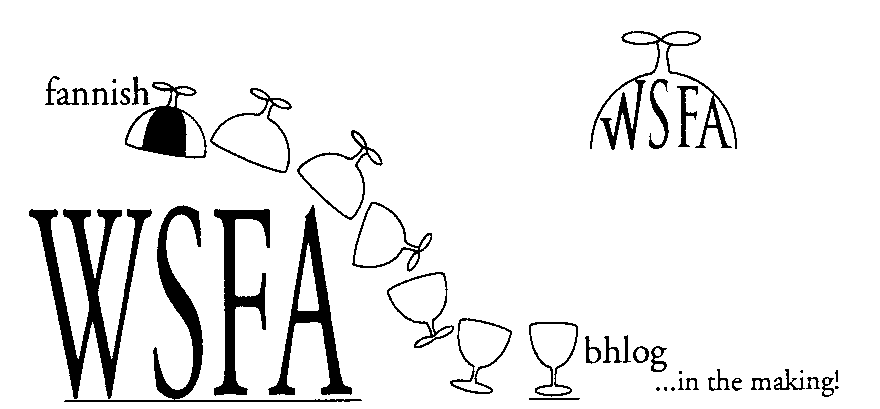

The Official Newsletter of the Washington Science Fiction
Association -- ISSN 0894-5411
Edited by Joe Mayhew
The Fokker Einflapper, E-7
WSFA Minutes August 4th at Ginter's
Talking to the Shiny Spot
Science Fiction Thrillers
Life on Planet Ed
The Fokker Einflapper, models E-1 to E-7, was the only ornithopter used during the first World War by either side. Shown here is the E-7 which was flown briefly by Count Max Immelman of Boelke Squadron.
Designed by Gustav Fokker, Anthony Fokker's brilliant but demented uncle, it featured a very sophisticated wing design using carbon-epoxy laminates combined with an equally sophisticated transmission which permitted the blades to rotate and flex on the up stroke while holding firm and rigid on the down, or power stroke. Unfortunately, the bicycle chain technology of 1914 was not up to the challenge, and the Einflapper fell into disuse because of excessive maintenance requirements.
Powered with an 80 hp Oberursel rotary engine, the E-7 had a top speed of 82 mph in level flight, and could climb to 6600 feet in 20 minutes.
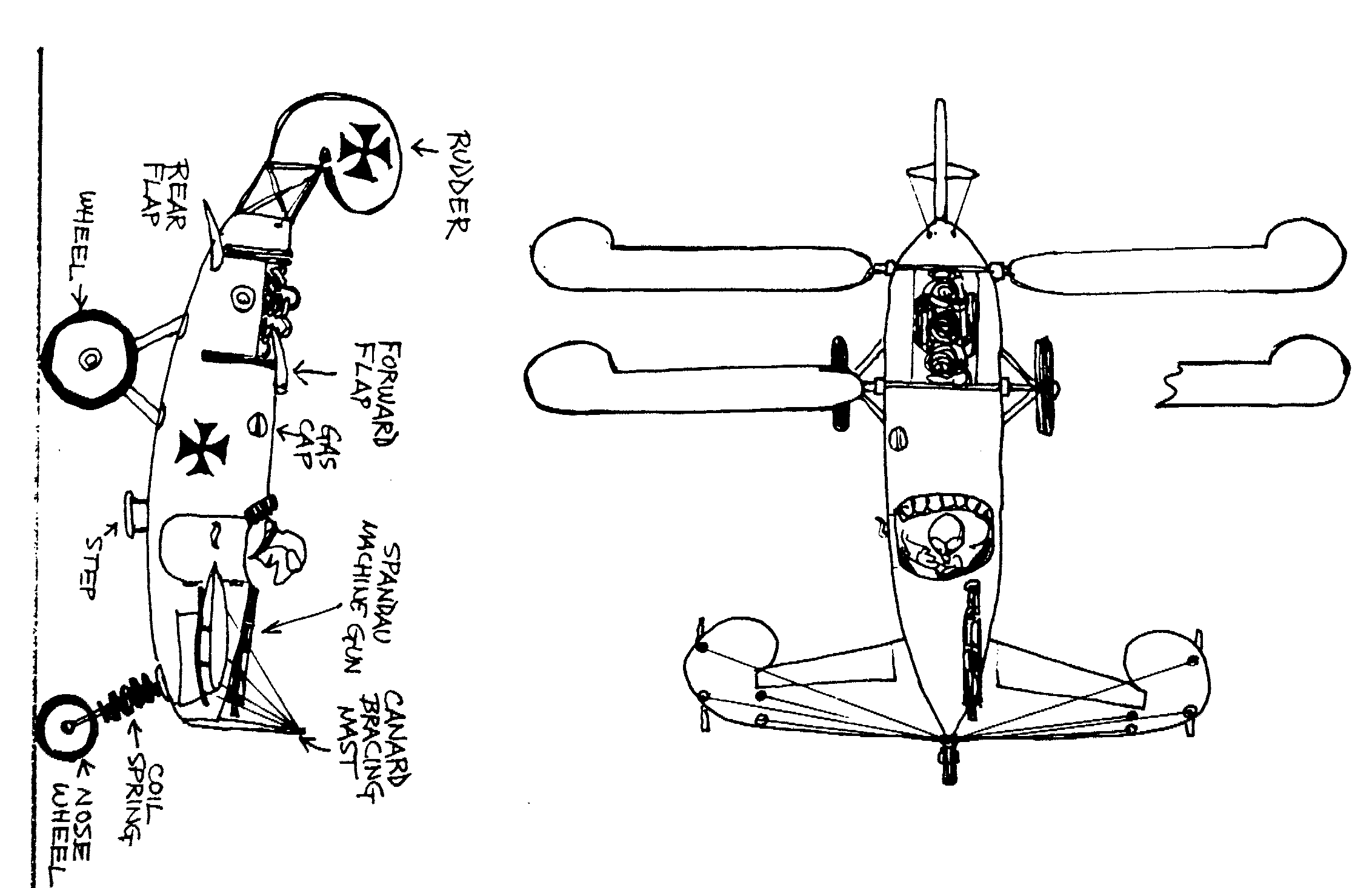
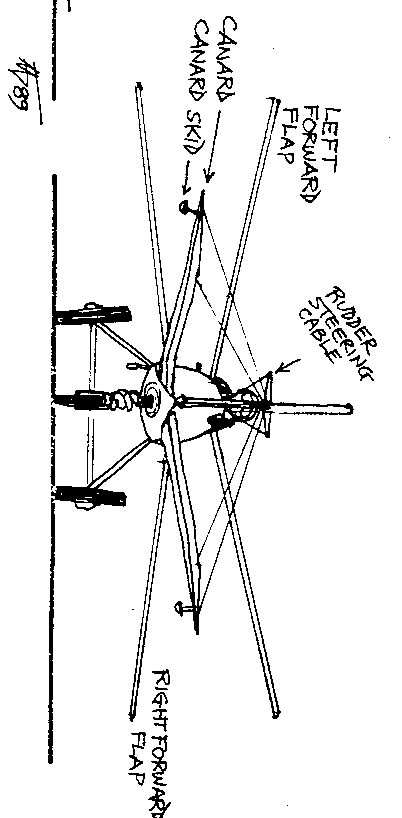
Attending: VP. Terilee Edwards-Hewitt, Sec. Joe Mayhew, Treas. & 96 Chair Bob MacIntosh, Trust. Jim Edwards-Hewitt, Trust. John Pomeranz, 97 Chair Mike Nelson, Dan Burgess, Elspeth Burgess, Chris Callahan, Steven desJardins, Alexis Gilliland, Erica Ginter, Dan Hoey, Eric Jablow, Bill Jensen, Keith Marshall, Walter Miles, Lance Oszko, Peggy Rae Pavlat, Evan Phillips, Sam Pierce, Dick Roepke, Rachel Russell, John Sapienza, George R. Shaner, Steven Smith, T R Smith, William Squire, Colleen Stumbaugh, Michael J. Taylor, Michael J. Walsh.
The meeting was called to order at 9:15 by VP Terilee Edwards-Hewitt. There was no outstanding agenda from the previous meeting. The next meeting will be at Gilliland's; the normal schedule will return for September [1st Friday = Gilliland's; 3rd Friday = Ginter's].
Bob MacIntosh reported the Treasury balance at $4,182.11.
DISCLAVE 1995: Dan Hoey, Chair of the 1995 Disclave handed over a check for 4,000.00 from his Disclave's account [ with perhaps more to come!] He thanked all who helped.
DISCLAVE 1996: Bob, given his druthers would choose the Hyatt Regency (near Union Station), site of sliding naked policemen. If they can survive the NYC cops, they're probably up to Fandom's Finest.
DISCLAVE 1997: Michael Nelson would like to sign with the same hotel for his con, giving the con the advantage of being in the same site again. Besides, he reported, licking his chops, "They gave us a nice lunch."
THERE WAS NO BUSINESS CONDUCTED
No announcements were given to the Secretary in writing.
The meeting was adjourned at 9:25.
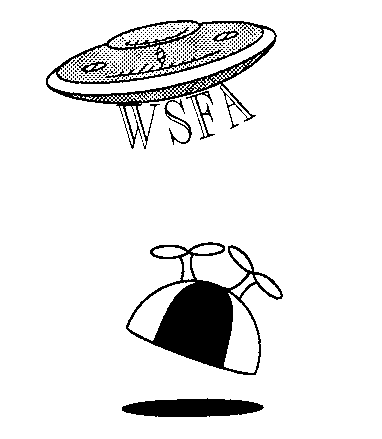
John Pomeranz and Kathi Overton decided to do a Public Access Science Fiction program on their local station, Channel 33 in Arlington. About that time I became the Library of Congress' Recommending Officer for Science Fiction. Since my new title sounded like I reviewed books for Congress (what I actually did was decide which SF LC would keep, what it would try to get and things like that) John and Kathi hired me on as SF book reviewer for their new show FAST FORWARD. I've been doing it ever since, despite the change of management to "Da Guys" = Tom Schaad and Mike Zipser, who kept me on.
The studio is on the third floor of George Mason University's Law School. It isn't posh. In the winter, the pipes across the ceiling of the sound studio clank and grumble sounding like the robots are restless; which may well be appropriate for SF.
For a while, John tried to use a home-made prompter (Two broom handles in a cardboard box onto which the text was attached and hopefully rolled across an opening in the box) held up beside the camera. It would jamb or spring the text around so that it was abandoned in favor of ad libbing and re-taping. I used a script on my first review, but have babbled off the top of my head ever since.
I sit there in my old blue blazer, tie and shirt (that I only wear for FAST FORWARD) behind a table covered with the better half of a rag with a microphone on my lapel. Sometimes there is a cameraman. Sometimes there is only Tom Schaad who focuses the camera and runs back into the control booth to push buttons and whatever else they do back there. Kathi was a marvel to watch. She ran the booth like an organist playing Bach. Tom is getting so he can make the damned thing do what he wants it to, but nobody has style like Kathi.
I am the "talent". The "talent" is what the light bounces off of in front of the camera. My job is to chat up the shiny spot in the camera's lens and, when I'm done, continue smiling at it for about 5 seconds. I frequently forget to do that, making the transition to the next item a split second patch for Tom. I'll try harder next time. Sometimes we keep the first tape. Sometimes we keep the seventh or eighth. It would be nice if we could splice the good bits from several review attempts just keep on taping until one more or less works (or, perhaps, Tom gives up hope).
Somehow, despite the primitive equipment, Tom and Mike are producing a rather professional looking show which is now being seen in Michigan, New York, Colorado and in all of the Washington Metropolitan area except Prince George's County (which is, naturally, where I live). Actually, I usually see the program on VCR tape about six months after it is aired.
We usually show the books I am reviewing. Sometimes what I have read is the set of bound galleys and we don't actually have the finished book. In those circumstances we get them to send a cover, which we wrap around a book of similar size and shoot it.
What we showed on camera during my review of the WSFA press Lewis Shiner book THE EDGES OF THINGS, was a color xerox of a cover proof that wasn't the same size as the finished book. For my review of David Feintuch's CHALLENGER'S HOPE the book we showed had "NOT FOR SALE" printed on its cover, which I hope didn't undermine my rave review.
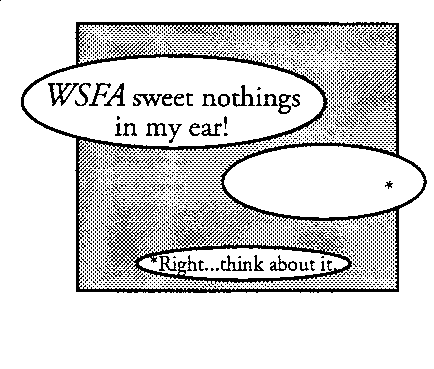
The science fiction and thriller genres are closely linked. Many of the James Bond movies and books by the likes of Tom Clancy contain science fictional elements. After all, war between the Soviet Union and NATO never happened, making the RED STORM RISING as much a work of alternate history as the books set in universes where the Nazis or the South won their respective wars. But there is a slight difference in approach. While your mainstream thriller may use gadgets, the emphasis is on what they can do. In science fiction thrillers, there is more weight on how they are made or the implications of what they can do.
Neal Stephenson's ZODIAC is much less complicated than his SNOW CRASH or THE DIAMOND AGE; in fact it is close to being a conventional thriller. It is set at most a few years in the future with the hero functioning as a "Granola James Bond" or what he thinks of as a "Toxic Spiderman" working for the Group of Environmental Extremists fighting the polluters through public relations spectacles, pouring concrete into pipes, and measuring the environment through lobsters. This is not -quite- cyberpunk although the hero is clearly part of the counterculture, referring to bacon as a carcinogen and he doesn't turn down nitrous oxide.
A first person narrator, Sangamon admits to being annoying, "One of the problems, hand out with me, is that I can turn any topic into a toxic horror story. I've lost two girlfriends and a job by reading an ingredients label out loud, with annotations, at the wrong time." However, he makes up for that by being amusing and quite capable, early in the book we see him bring a polluter company to its knees by the strategic placement of toilet gaskets and salad bowls.
The science fictional element in this book is fairly minor, the leakage of a genetically engineered bacteria that causes a virus into Boston Harbor which, when Sangamon comes close to discovering it, leads the polluters to frame him as an environmental terrorist and try to kill him (notably in a wonderful scene where thugs with guns are out-maneuvered by our hero in the Zodiac boat of the title.) Meanwhile, the scientist who created the virus, now infected with it, is out to become a real terrorist, by killing the presidential candidate who masterminded the creation of the bacterium.
The real science here is that of environmentalism. The hero is earnestly worried about the environment and the ways in which the polluters try to deceive the public with comparisons like an eyedropper's worth in a football field and portraying the environmentalists as extremists. This both fits his character and provides an alternative voice in science fiction to conservatives like Jerry Pournelle who paints environmentalists as the villains in FALLEN ANGELS.
In short, this is a sf book that will appeal to fans of the mystery and thriller genres as well as to those who enjoyed SNOW CRASH and Stephenson's other works.
Stephen Bury's INTERFACE tries to be a similar cross-over book between sf and thriller. In it a conspiracy of the wealthy and usual suspects try to take control of the United States when the president tries to postpone paying the National Debt. Their vehicle is a former football star and governor who is cured from a stroke by a device that also feeds the results of a focus group directly into his brain. So his speeches and positions automatically reflect that of a majority of the population.
INTERFACE has several major flaws. While the cover copy emphasizes the political elements, most of the book is spent creating the device and making it work. This shows the book's sf origins, but in this book, with these characters, it just doesn't work. Also, there is a long subplot about a former bag lady that eventually does connect with the main plot but in the early stages it is difficult to see where this is going. The biggest flaw is the lack of characterization. Only the former bag lady, a grouchy senator, and the daughter of the governor/presidential candidate seem to have a personality enough to make the reader care about them. The surgeons and engineers and political consultants are there to do their jobs and little else.
The book only catches on when the election is over and the conspiracy must be defeated. But it takes far too long getting to this point. And, unlike ZODIAC there is little to hold the reader's attention in terms of language, character, or plot until this point. My recommendation is to avoid this one.
World War Two is science fiction's favorite war. Compare the number of sf novels about WWII to that of WWI or Vietnam and you'll find more. In part it's that WWII was the last war where the U.S. were among the unquestioned "good guys", in part it is that WWII was ended by the atomic bomb, a device that was considered science fiction by most up to Hiroshima. But suppose the bomb was never built? Or rather suppose a 1990s style anti-nuclear activist with the appropriate technical training was somehow (the exact mechanism is conveniently blurry) accidently transported back to Los Alamos while trying to sabotage a nuclear experiment and winds up back 1943 in time to stop the building of the bomb?
That's the premise of Kevin J. Anderson and Doug Beason's THE TRINITY PARADOX. The anti-nuclear activist Elizabeth Devane transported back to 1943 accidently while trying to sabotage a nuclear experiment seems to accept what has happened too quickly, "Elizabeth had never done drugs back at Berkeley, so this wasn't some sort of flashback. Maybe she had hit her head in the explosion, she thought. Maybe none of this was really happening. Maybe it was." This about the extent of her introspection--and of the quality of writing. She is willing to accept this 1943 as a hallucination until the vividness of her surroundings forces her to recognize the truth.
The real attention grabber here is the situation and Elizabeth's attempts to stop the bomb from being built, not the writing or characterization. The project's managers assume anyone at the Project Site had already passed security and Elizabeth easily completes a midnight raid to write her own credentials. From there the focus shifts to the building of the bomb and Elizabeth's efforts to stop it.
There are some interesting moments such as when Elizabeth compares the lackluster security at Los Alamos during wartime to what she knows of 90's weapons project and when the feminist Elizabeth confronts 40's ideas of women's place in the world -- although she knows 1990s' physics, as a woman she is assigned as a human calculator, a position from which she tries to sabotage the project by adding numbers incorrectly. She even at one point tries to assassinate a key member of the project. And the best line is given to a German, after Professor Heisenberg is executed by the German authorities for treason, the executioner mocks, "No more uncertainty about your principles now, Herr Professor."
For this book is not only a thriller but an alternate history. A remark by Elizabeth revealing what she knows of a key German mistake in their research is heard by a British scientist who believes more in the universality of science than in winning the war. When he communicates this information to a German friend, Los Alamos enters a true race for the bomb and Elizabeth finds her future knowledge less and less useful and her loyalties less clear cut.
Here too politics plays a part, although more on the conservative side. Elizabeth's position as an anti-nuclear activist becomes the authors' straw-man, never really analyzed or explained until she starts losing them in the grip of Nazi atrocities. This lessens the effect of her characterization, not the authors' greatest strength, and her shifting position on building the bomb. In this book, the bomb becomes a weapon of defense against the Nazi evil and those who protest the development of weapons are fools relying on the benevolence of others. Surprisingly, this book was written after the fall of the Iron Curtain, without a single shot fired, and the beginning of the disintegration of the Soviet Union.
In short, the science fiction thriller, while related to its best-selling counterpart, has a somewhat different slant. The suspense comes from the devices and the science -- will they be built in time, will the truth be discovered in time -- rather than just trying to outshoot or outrun the opponent. The science fiction thriller therefore has a slightly different flavor and tone than the its close kin, the military thriller and adventure thriller, even when the sf element is low-key.
